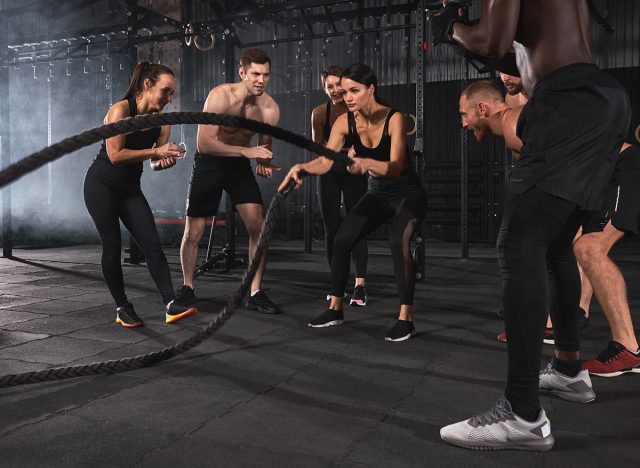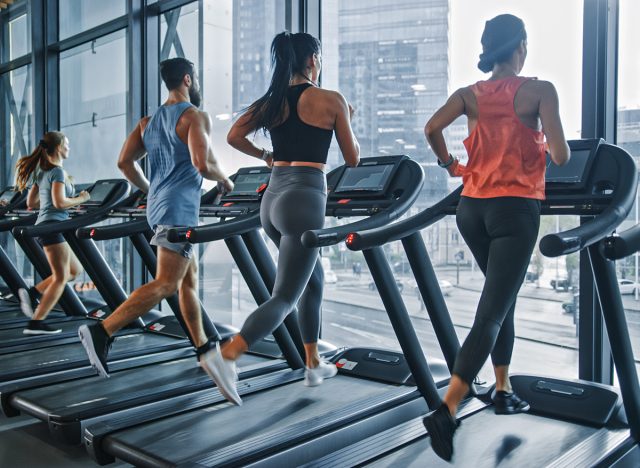11 Top Fitness Trends Right Now, According to an Industry Expert

The top 11 fitness trends right now are constantly evolving and new ones arise every year. And as a certified as a personal trainer through the American Council on Exercise, I've compiled the most notable here for some inspiration and consideration.
Before you dive in: My best advice is to avoid trying to do too many new things at once. Almost always, introducing one new habit at a time and mastering it before moving onto another is the way to find success. Incorporating multiple new trends into your daily routine all at the same time is a recipe for overwhelm, which can ultimately lead to giving up.
Start by choosing one habit or trend that you feel most called to and mastering that. This leads to a sense of self-efficacy—the feeling that you are capable and can do anything you put your mind to—which leads to even more positive habit creation in the future.
Intuitive Exercise

In 2023, there was a big shift in the fitness industry from strict regimens and "hustle fitness" to a more intuitive approach. People are beginning to recognize the benefit in listening to how one's body feels and planning the day's exercise around that. Of course, there is merit to having a strong sense of discipline, especially if one is training for an event such as a marathon, CrossFit competition, obstacle course race, or another event. But there is also a great deal of value in truly knowing when to allow your body extra rest, when to perform cross-training, and when to push your limits. I believe we'll also see a focus on making exercise fun, as more and more people begin to realize that some movement—any movement—is better than no movement, and the best way to stay consistent is to actually enjoy it.
Outdoor Exercise

The health benefits of exercise are well-known, and so are the health benefits of nature exposure. Over the last several years, we've seen platforms like Strava and AllTrails experience a boom in membership and popularity. Additionally, more evidence about the importance of access to green spaces has surfaced. Open-air gyms and trail activities are becoming more popular, and we will continue to see a rise in outdoor activity and "wellness as tourism" as a result.
RELATED: 10 Tips For Effective Fat Loss Without Extreme Dieting
Longevity as a Desired Outcome

Much of the fitness industry is moving away from aesthetics as an end goal and moving toward longevity as a desired result from fitness regimens. People are realizing that physical fitness is an incredibly important part of maintaining functional independence as they get older, and training programs reflect that by focusing on compound functional movements, muscle strengthening, balance, and coordination.
Exercising for Mental Health

Likewise, mental health as an outcome of exercise is seemingly becoming more important than aesthetics as an outcome of exercise. More and more research continues to come out regarding the profound benefits of exercise for mental health, particularly depression and anxiety. Movement has been called a "first-choice treatment" for depressive disorders and researchers have concluded it to be more effective than medication to manage mental health..
GLP-1s

The rise of GLP-1s and off-label use of them has created a false perception of what it takes to lose weight in a healthy, sustainable way. Originally prescribed for diabetes management or weight loss under the supervision of a medical doctor, GLP-1s are now easily available to the masses and often used by individuals who don't meet diagnostic criteria. This is a slippery slope and when consumers aren't properly educated on potential drawbacks of a drug and/or proper usage, it can be dangerous. Importantly, we still don't know the true long-term implications of this class of drugs.
It will be important for medical professionals to discourage off-label or improper use of these drugs, as well as for fitness and nutrition professionals to educate consumers on the importance of physical activity and healthy nourishment for life—not just for weight loss.
However, it's not all bad. For the right patients, GLP-1s can be the first step in the right direction toward a healthier life. I hope that the continual rise of GLP-1s comes with an increase in communication around potential side effects, the fact that these drugs don't work for everyone, and most importantly, that this isn't a miracle cure. I believe 2024 will bring about a change in communication related to GLP-1s, specifically that there's still no "magic pill" and that regular exercise and proper nutrition are still the No.1 way to manage one's weight, though some weight loss drugs can help when properly prescribed, used, and managed.
Gyms as Health Ecosystems

Gyms are becoming more than gyms. Increasingly, big-name box gyms like LifeTime are adding health, nutrition, and medical services, and "recovery lounges" to create all-in-one ecosystems for health, fitness, and medical care.
Smart Personal Training

Virtual personal training platforms are continuing to take off, with more entering the market on a regular basis. Between AI-driven workout machines like Tonal, Tempo, and Aviron, and individualized platforms like Future and Caliber, consumers have no shortage of personalized training options.
Related: This Is Exactly How to Lose Body Fat This Year
Food as Medicine

"Lifestyle medicine" is nothing new, and neither is the "food as medicine" concept, but I believe 2024 will bring a bigger emphasis on the latter as more and more people learn about the healing power of a nutritious diet. Homesteading is also seeing an increase in popularity, as people want to be more in control of what they eat.
Wearable Technology and Health/Performance Tracking

Technology in fitness isn't going anywhere. The past several years have brought new tech wearables to the market and 2024 will be no different. People are interested in their physical performance, even if they aren't competitive athletes. Tracking stats like pulse ox, HRV, RHR, body temperature, and sleep will continue to become more fine-tuned and drive the habits of active people. Notably, some experts think that too much tracking can have negative effects, so it's important to balance the statistics your watch gives you with a healthy amount of listening to your body.
Social Fitness

Despite being constantly connected to others via the Internet and social media platforms, loneliness is an epidemic in America. Social fitness opportunities, like community walks, run groups, and in-person fitness classes will become increasingly popular, as will social fitness networking platforms like Strava.
Focus on Cycle Tracking for Women

In the last couple of years, light has been shed on how profoundly a female's menstrual cycle affects physical performance. On social media, it's easy to find posts and videos about how to train during one's luteal, follicular, ovulation, and menstrual phases. Companies like Wild.AI are conducting research and working with women to create solutions for training, nutrition, and recovery based on cycle patterns. I think in 2024, we'll see an increased emphasis on this, thus an increase in female athletic performance across the board.
Final Word From the Expert

I definitely see a continued emphasis on outdoor exercise, exercise for mental health, social fitness, and enhanced wellness/fitness tracking. I don't see GLP-1s going anywhere, and I do think we'll continue to see the introduction of new obesity drugs. However, I hope to see better communication and more honest marketing around these drugs, as well as more (and better) education from medical providers and nutrition/fitness professionals.
The takeaway is that regular exercise, a nutritious diet, good sleep, and proper hydration remain the foundation for a healthy lifestyle. Other than these pillars, it's important to be mindful of mental health and social wellness, too. It can feel like a lot to balance at times, but finding routines and activities that make you happy is the key to long-term success.
Amanda Capritto, CPT, CSNC, CES, is a fitness trainer at Trainer Academy




